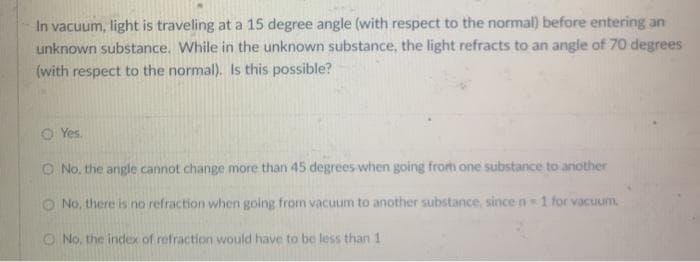In vacuum, light is traveling at a 15 degree angle (with respect to the normal) before entering an unknown substance. While in the unknown substance, the light refracts to an angle of 70 degrees (with respect to the normal). Is this possible? O Yes. O No, the angle cannot change more than 45 degrees when going from one substance to another O No, there is no refraction when going from vacuum to another substance, since n 1 for vacuum O No, the index of refraction would have to be less than 1
In vacuum, light is traveling at a 15 degree angle (with respect to the normal) before entering an unknown substance. While in the unknown substance, the light refracts to an angle of 70 degrees (with respect to the normal). Is this possible? O Yes. O No, the angle cannot change more than 45 degrees when going from one substance to another O No, there is no refraction when going from vacuum to another substance, since n 1 for vacuum O No, the index of refraction would have to be less than 1
Related questions
Question

Transcribed Image Text:In vacuum, light is traveling at a 15 degree angle (with respect to the normal) before entering an
unknown substance. While in the unknown substance, the light refracts to an angle of 70 degrees
(with respect to the normal). Is this possible?
O Yes.
O No, the angle cannot change more than 45 degrees when going from one substance to another
O No, there is no refraction when going from vacuum to another substance, since n1 for vacuum.
O No, the index of refraction would have to be less than 1
Expert Solution
This question has been solved!
Explore an expertly crafted, step-by-step solution for a thorough understanding of key concepts.
This is a popular solution!
Trending now
This is a popular solution!
Step by step
Solved in 2 steps
